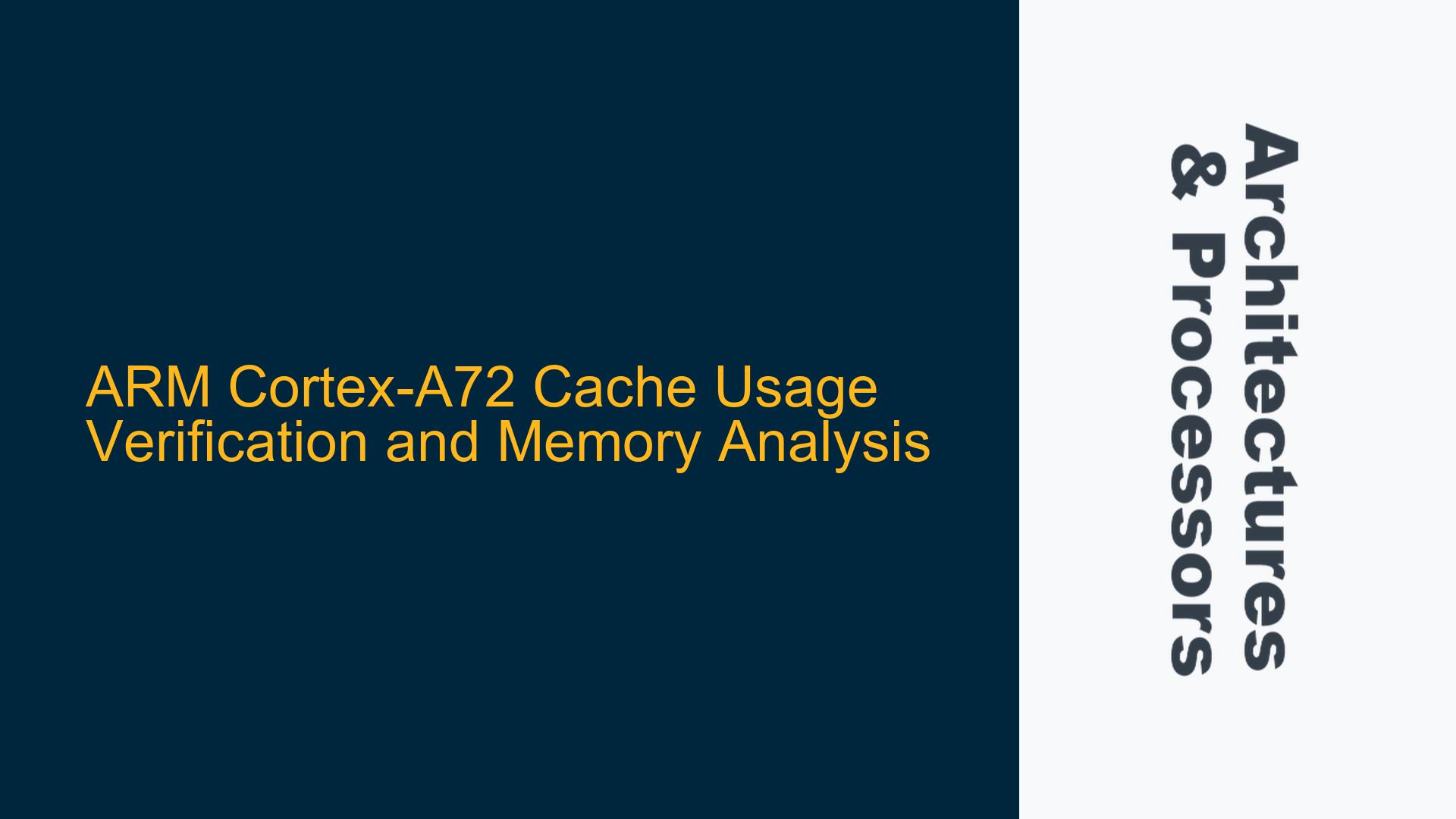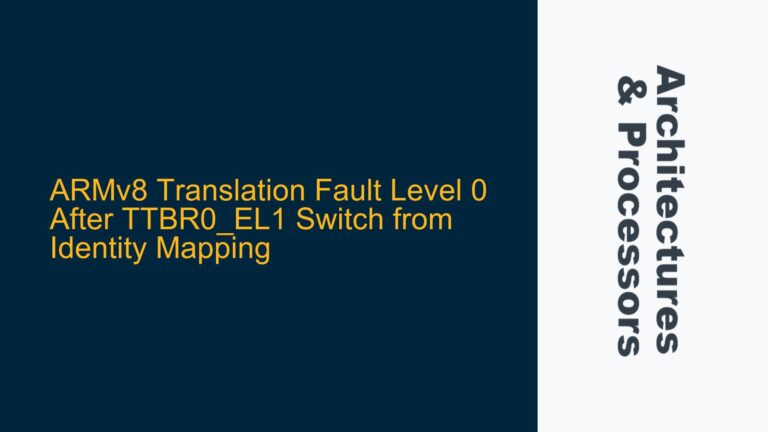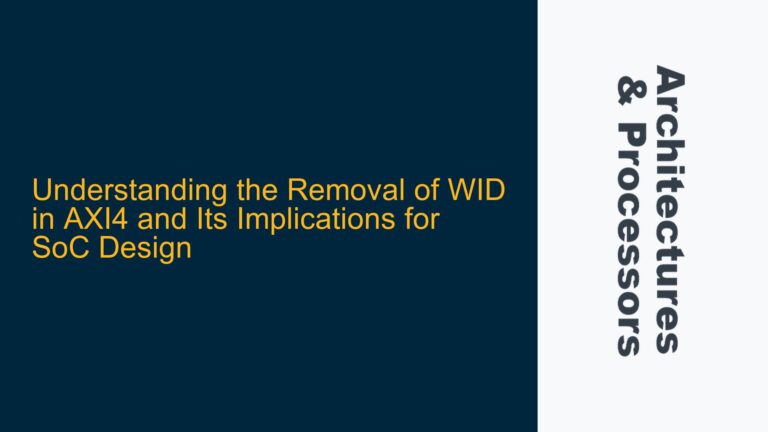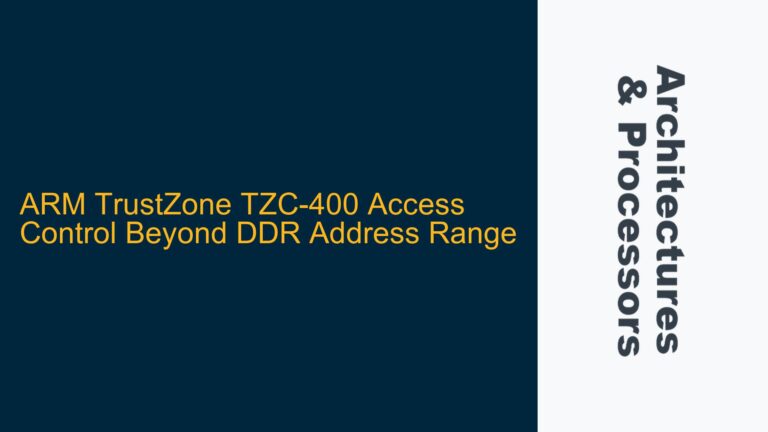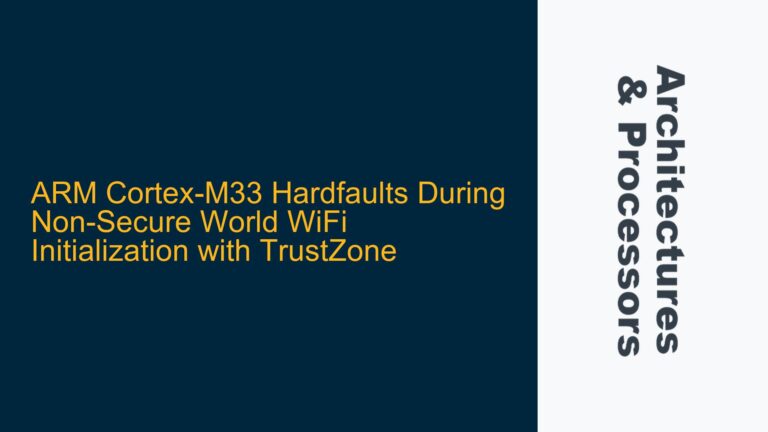ARM Cortex-A72 Cache Utilization and Memory Section Mapping
The ARM Cortex-A72 processor, a high-performance core within the ARMv8-A architecture, employs a sophisticated memory hierarchy to optimize execution speed and reduce latency. A critical component of this hierarchy is the cache memory, which stores frequently accessed data and instructions to minimize the time spent waiting for data from slower main memory (typically DDR). Understanding whether your executing program is effectively utilizing the cache memory is essential for diagnosing performance bottlenecks and ensuring optimal system behavior.
By default, the ARM Cortex-A72’s Memory Management Unit (MMU) maps all memory accesses through translation tables, which define the memory attributes for each region, including cacheability. These attributes determine whether a memory region is cached, uncached, or write-through/write-back cached. The MMU translation tables are initialized during system boot, and their configuration dictates how the processor interacts with memory.
To verify whether your program is using cache memory, you must first understand the memory attributes assigned to the regions where your code and data reside. This involves examining the MMU translation tables, analyzing the memory sections used by your process, and potentially profiling cache behavior using performance monitoring tools.
MMU Translation Table Configuration and Cache Attributes
The ARM Cortex-A72’s MMU translation tables define the memory attributes for each memory region, including cacheability, shareability, and access permissions. These attributes are critical in determining whether a memory region is cached and how the cache operates (e.g., write-back or write-through). By default, most systems configure DDR memory as cached, but this can vary depending on the platform and software configuration.
The MMU translation tables are typically initialized during the boot process by the bootloader or operating system. The tables are hierarchical, with multiple levels of page tables that map virtual addresses to physical addresses. Each entry in the translation tables includes memory attributes that control how the processor interacts with the corresponding memory region.
To determine whether your program is using cache memory, you must locate and analyze the MMU translation tables. This involves identifying the base address of the translation tables, which is often stored in the Translation Table Base Register (TTBR0 or TTBR1). Once you have access to the translation tables, you can examine the memory attributes for the regions where your code and data reside.
For example, if your program’s code and data are mapped to a region with the "Normal Memory" attribute and the "Inner Write-Back Write-Allocate Cacheable" attribute, the processor will use the cache for memory accesses within that region. Conversely, if the region is marked as "Device" or "Non-cacheable," the processor will bypass the cache for memory accesses.
Profiling Cache Behavior and Memory Section Analysis
In addition to examining the MMU translation tables, you can profile the cache behavior of your program to verify cache usage. The ARM Cortex-A72 includes Performance Monitoring Units (PMUs) that provide detailed insights into cache hits, misses, and other performance metrics. By configuring the PMUs to monitor cache-related events, you can gather data on how effectively your program is utilizing the cache.
To profile cache behavior, you must first identify the relevant PMU events for cache monitoring. For example, the "L1 Data Cache Access" event counts the number of accesses to the L1 data cache, while the "L1 Data Cache Miss" event counts the number of cache misses. By comparing these events, you can calculate the cache hit rate and determine whether your program is benefiting from cache memory.
In addition to cache profiling, you should analyze the memory sections used by your process to understand how memory is allocated and accessed. The memory sections include the code (text) section, data section, stack, and heap. Each section may have different memory attributes and cache behavior, depending on how it is mapped in the MMU translation tables.
For example, the code section is typically marked as cacheable to improve instruction fetch performance, while the stack and heap may have different cache attributes depending on the application’s requirements. By analyzing the memory sections and their attributes, you can identify potential performance bottlenecks and optimize cache usage.
Implementing Cache Verification and Optimization Techniques
To verify and optimize cache usage on the ARM Cortex-A72, you can implement several techniques, including MMU translation table analysis, cache profiling, and memory section optimization. These techniques require a combination of hardware knowledge, software tools, and performance analysis skills.
First, you must analyze the MMU translation tables to verify the memory attributes for your program’s code and data. This involves locating the translation tables, examining the relevant entries, and ensuring that the cache attributes are correctly configured. If the attributes are incorrect, you may need to modify the translation tables or adjust the memory mapping in your software.
Next, you can profile the cache behavior using the ARM Cortex-A72’s PMUs. This involves configuring the PMUs to monitor cache-related events, running your program, and analyzing the collected data. By identifying cache misses and other performance issues, you can optimize your code and data layout to improve cache utilization.
Finally, you should analyze the memory sections used by your process to ensure that they are optimally configured for cache usage. This may involve adjusting the memory attributes for specific sections, reorganizing data structures to improve cache locality, or using prefetching techniques to reduce cache misses.
By combining these techniques, you can verify and optimize cache usage on the ARM Cortex-A72, ensuring that your program benefits from the low latency and high performance provided by cache memory. This process requires a deep understanding of the ARM architecture, but with the right tools and techniques, you can achieve significant performance improvements.
Detailed Analysis and Techniques
MMU Translation Table Analysis
The MMU translation tables are the cornerstone of memory management on the ARM Cortex-A72. They define how virtual addresses are mapped to physical addresses and specify the memory attributes for each region. To analyze the translation tables, you must first locate the base address of the tables, which is stored in the TTBR0 or TTBR1 register. The choice between TTBR0 and TTBR1 depends on the virtual address range being accessed.
Once you have the base address, you can traverse the translation tables to find the entries corresponding to your program’s memory regions. Each entry includes the physical address, memory attributes, and access permissions. The memory attributes control cacheability, shareability, and memory type (e.g., Normal, Device).
For example, a typical entry for a cached memory region might include the following attributes:
- Memory Type: Normal
- Cacheability: Inner Write-Back Write-Allocate
- Shareability: Inner Shareable
If your program’s memory regions are not marked as cacheable, you can modify the translation tables to enable caching. However, this requires careful consideration of the memory type and shareability attributes to ensure correct operation.
Cache Profiling with PMUs
The ARM Cortex-A72’s PMUs provide a powerful tool for profiling cache behavior. To use the PMUs, you must first configure them to monitor the relevant events. This involves writing to the Performance Monitor Control Register (PMCR) and selecting the events to monitor using the Performance Monitor Event Select Registers (PMSELR).
For cache profiling, you can monitor events such as:
- L1 Data Cache Access
- L1 Data Cache Miss
- L2 Cache Access
- L2 Cache Miss
By comparing the number of cache accesses and misses, you can calculate the cache hit rate and identify performance bottlenecks. For example, a high cache miss rate may indicate poor cache locality or inefficient data access patterns.
To collect PMU data, you can use performance monitoring tools such as perf on Linux or custom firmware for bare-metal systems. These tools allow you to run your program, collect PMU data, and analyze the results to identify cache-related issues.
Memory Section Optimization
The memory sections used by your process play a critical role in cache utilization. Each section has different access patterns and performance requirements, so optimizing their configuration can significantly improve cache performance.
For example, the code section is typically read-only and benefits from being marked as cacheable. The data section, which includes global and static variables, may have mixed access patterns and should be carefully analyzed to ensure optimal cache usage. The stack and heap are dynamic memory regions that may require special attention to avoid cache thrashing.
To optimize memory sections, you can:
- Adjust the memory attributes in the MMU translation tables to enable caching for specific sections.
- Reorganize data structures to improve cache locality.
- Use prefetching techniques to reduce cache misses.
For example, if your program frequently accesses a large array, you can reorganize the array to improve spatial locality or use prefetch instructions to load data into the cache before it is needed.
Practical Example: Verifying Cache Usage
To illustrate these techniques, consider a practical example where you want to verify whether a specific function in your program is using cache memory. The function operates on a large dataset stored in DDR memory, and you suspect that cache misses are causing performance issues.
First, you analyze the MMU translation tables to verify the memory attributes for the dataset. You locate the translation table entry corresponding to the dataset’s memory region and confirm that it is marked as cacheable. Next, you configure the PMUs to monitor cache-related events and run the function. After collecting the PMU data, you analyze the cache hit rate and identify a high number of cache misses.
To address this issue, you reorganize the dataset to improve cache locality and use prefetch instructions to load data into the cache before it is needed. After making these changes, you rerun the function and observe a significant reduction in cache misses and improved performance.
Conclusion
Verifying and optimizing cache usage on the ARM Cortex-A72 requires a deep understanding of the memory hierarchy, MMU translation tables, and performance monitoring tools. By analyzing the MMU translation tables, profiling cache behavior, and optimizing memory sections, you can ensure that your program benefits from the low latency and high performance provided by cache memory. This process is essential for diagnosing performance bottlenecks and achieving optimal system behavior on ARM-based platforms.
